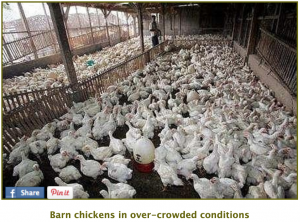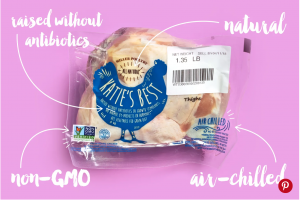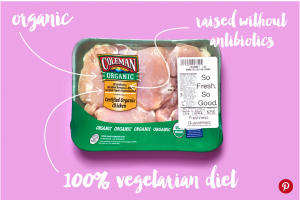Surf & Turf: Uncovering The Meat Industry
The Ugly Truth Behind Your Delicious Chicken
Ruhie Mehra
Who doesn’t love a well-cooked piece of chicken? You can grill it or fry it and spice it up in any way that you may like, and it doesn’t burn a hole through your wallet either! After all, chicken is healthy meat, expensive or cheap… Right? A trip down to the grocery store, made me take a deep dive into the differences between expensive (organic) and cheap (conventionally grown) chicken meat. I noticed that the conventional chicken meat had sold out a lot faster than the organic chicken meat, due to its lower prices, and despite the healthier labels on the organic chicken packages. The price of the conventional chicken was about $3 for one pound of the breast, and the organic chicken breast of similar weight was charged at about $7. I needed to understand why this striking difference in price and quality of the meat occurred. After doing some research, it is clear that while cheaper chicken meat is appealing to purchase, it comes with (detrimental) hidden costs that have disastrous effects on the environment, the working conditions in the chicken meat industry, and our very own health.
CONVENTIONALLY GROWN CHICKEN:
RAISING & DEATH:
When it comes to raising, handling, and slaughtering chickens in a conventional and less costly manner, the procedure differs from raising organic chickens. Cheaper priced and conventionally industrial chicken tends to be raised in harmfully inappropriate conditions. They are constantly fed genetically modified organisms (GMO) which are loaded with hormones and genetically modified corn and soy (Auld,2017). This modified feed tends to make the chickens grow fatter and faster, so they can sell quickly and at a good price. According to CountryFarm Lifestyle, these chickens have a short lifespan of about three to six months, before they get slaughtered (Country farm Lifestyle, n.d). This short lifespan of the chicken leads to the farmers being able to increase their turnover and revenues while selling more unhealthy meat. Furthermore, these chickens are chemically cleaned with chlorine after being slaughtered, versus regular organ sanitizer and iced water. Chlorine makes it impossible to detect any bacteria and salmonella in the meat, both of which are harmful to the human body (Soil Association, 2020). This chlorine-based technique approves the chicken meat for selling a lot faster and is a much cheaper method of cleansing the meat. Despite this unhealthy method of handling and slaughtering, a majority of consumers purchase the cheaper meat, as the organic chicken meat is too expensive in comparison and they falsely assume all chicken meat is healthy.
IMPACT ON OUR HEALTH:
A huge concern that gets raised when it comes to eating chicken, is the effect that it has on our health. Cheaper and more modified chickens carry significantly more fat than protein in their bodies. According to The Times, a lot of their meat is unhealthy and lacks nutrition. So, when consumers eat industrial chicken, they are consuming more fat than protein, which defeats the health purposes of eating chicken(Leake, The Times, 2019). “Eating industrial chicken that sells for cheap can lead to obesity, heart conditions, stomach ulcers, etc.,” says Arnarson. According to Jonathan Leake from The Times, the fat from the chicken leads to the clogging of the arteries and increases our own body fat percentage. He sheds light on the fact that the chlorine used to clean these chickens tends to slowly erode our heart muscles over the years, which is the leading cause of heart issues related to industrial chicken consumption(Leake, The Times, 2019) . The hormones and feed of these chickens are modified with medications that do not sit well with our digestive systems and are the main cause of stomach ulcers as the bacterial content leads to h pylori, a bacterial infection that erodes the stomach lining (Arnarson, 2017). Shocking statistics show that industrial chicken can lead to a 12% higher risk of cancer and about 25% higher risk of heart diseases (Arnarson, 2017). While cheaper, conventional chicken meat is tastier and more filling for a lower cost, it comes loaded with hazardous side effects that are prone to harm our bodies and organs in innumerable ways.
DECODING THE LABELS:
So far, we have understood what goes into the raising of industrial chickens, and how their meat affects our bodies. Next, it’s informative to understand the different labeling related to chicken packaging. Cheaper chicken usually doesn’t have any fancy terms on the packaging, but it does come with the basic information about the nutritional value (sugar, Protein, carbs, sodium), of the chicken and the FDA approved stamp (Foster,2014). They also require the Animal Welfare Humane Certificate stamps (AWHC) in order to prove their eligibility for the humane treatment of the chicken.


Both of these are images of conventionally industrial chicken meat- they do not come with the labels that organic chicken packaging comes with.
CHICKEN HANDLING AND LIVING CONDITIONS:

While most people are ignorant about the living conditions of chickens, it’s vital for people to realize how unethical and mortifying it is to see the way industrial chicken farmers handle their stock, versus the organic chicken farmers. Cheaper, more industrial chickens are usually put to live in tiny cages inside factory farms. These farms stock up to 20 chickens a cage (Country farm Lifestyle, n.d), which leads to the chickens not having enough space to flap their wings. This sometimes leads to the chickens getting violent and pecking each other with their beaks. As a result of this, breeders cut off chicken beaks to avoid them from pecking each other, which is considered illegal in many countries across the world as it is extremely painful and can be compared to genital mutilation (Country farm Lifestyle, n.d). Chickens tend to keep digging at the ground, which leads to them picking up diseases and infections and they start eating the dust due to high hunger levels. Due to the overcrowding in the sheds, there’s low ventilation and the chickens often fall sick. They are pumped with hormones to grow faster and cannot support their own weight after a point, so they develop painful chronic diseases where they can’t stand or walk. According to CountryFarm Lifestyle, these chickens and are slaughtered in under four months of their birth.
ORGANIC CHICKEN:
RAISING & DEATH:
Moving forward, I would now like to shed some light on how organic chickens are different from conventional chickens, and why. Our so-called organic chicken is fed 100% unmodified feed that doesn’t contain growth hormones or any form of fattening agents, like GMOs (Auld,2017). According to Soil Association, these chickens are around for almost two years before they are slaughtered. After their death, they are rinsed with ice water and FDA certified sanitizers, despite it being a more expensive and time-consuming process (Soil Association, 2020). Their meat is all-natural and so is their feed. The high costs of breeding healthy chicken, are a large reason why multiple store owners across the country, prefer stocking cheaper, conventional chicken meat, as these high costs tend to get passed down to the storeowners.
IMPACT ON OUR HEALTH:
When compared to cheaper chicken meat, the more expensively priced packets of organic chicken, have different effects on our health. It is most certainly a better alternative as it has a higher protein content and a lower fat content. This is because of the difference in the chicken feed and the lack of modified elements in the feed of organically grown chickens. These chickens are also rinsed using unharmful liquids post their death, which prevents them from eroding our heart muscles (Arnarson, 2017). The overall risk of many illnesses like heart related diseases and obesity is lower when comparing organic chicken to industrial chicken. Organic chicken is also almost half as likely to be carrying Salmonella, in comparison to conventionally industrial chicken meat.
DECODING THE LABELS:
Organic and more expensive chicken packages come with different stamps. Some important ones to look for, that certifies it is more organic and healthier is the pasture-raised/pastured label: This refers to chicken that was raised on pastures and had access to edible vegetation, making it healthy. Organic chicken labels denote that the chicken was given feed that had no pesticides, chemicals, or antibiotics used to modify it (Foster,2014). Hormone and antibiotic-free labels ensure that neither hormones nor antibiotics were used to modify the chicken feed or the chicken itself, in any way. The “natural” label on packages refers to the fact that the chicken contains no added color or artificial preservatives. 1005 Vegetarian Diet refers to the fact that the chicken ate vegetarian food all its life, and didn’t consume any GMO. These labels signify the various healthy methods used to either feed or grow the chicken, which all industrial chicken packages lack. For this very reason, it is important to understand that organic chicken may be more expensive but comes with a lot of intricate precautions that industrial chicken meat lacks ( Foster,2014).


These are images of organic chicken packages that come with plenty of labeling.
CHICKEN HANDLING AND LIVING CONDITIONS:

The next comparison I would like to draw between industrial and organic chicken meat is the way organic chickens are raised and handled on the farm. chicken farmers let their chicken grow naturally over a period of almost two years. The chickens in cages have enough place to be comfortable and are let out on the farm occasionally. They eat the vegetation they can find, eliminating the risk of diseases and germs from consuming dust (Country farm Lifestyle, n.d). The vegetation they consume is natural as well, so the chickens tend to live peaceful and healthy lives. They are slaughtered after about two years of their birth and are cleaned with safe and certified substances, instead of chlorine.
CHICKEN BREEDING AND OUR ENVIRONMENT:
Ultimately, I would like to talk about the effects that raising and breeding chickens have on our environment. Unfortunately, chicken breeding harms the environment on an overall basis. Chicken breeding on a whole releases greenhouse gases like Carbon Dioxide from burning fossil fuels and nitrous oxide from chicken manure.
Annual chicken breeding can produce over 129 billion pounds of carbon dioxide emissions, which is the same amount as 12.37 million cars (Biological Diversity, n.d). Many farmers don’t have enough space on their lands to dispose of manure, so they get rid of it through the surrounding waterways. The manure in the waterways tends to add nitrous oxide and phosphorous to it which leads to rapid algae growth. This leads to the creation of aquatic dead zones, where the water poison levels are so high that no life can survive the area. Apart from this, breeding chickens consume so much water, that if an average American consumer gave up one chicken breast a week, they would be able to save up to 4321 gallons of water a year and this is equivalent to flushing the toilet 2,700 times (Biological Diversity, n.d).
As American consumers, we often equate good price to good quality. However, when it comes to purchasing chicken, most consumers are under the disillusion that chicken meat is extremely nutritious and healthy, regardless of its price. Consumers assume that even the most inexpensive and basic quality chicken meat pieces will give them the protein they are looking for, without realizing that more expensive chicken is significantly healthier for various reasons and in numerous ways. Thus, it seems important that American Consumers understand the differences between industrial and organic chicken meat, in order to avoid any information asymmetry regarding the disparities in the two types of chicken meat.
REFERENCES
Association, S. (n.d.). What is chlorinated chicken? Retrieved December 01, 2020, from https://www.soilassociation.org/causes-campaigns/top-10-risks-from-a-uk-us-trade-deal/what-is-chlorinated-chicken/
BSc, A. (2017, June 04). Why Processed Meat is Bad For You. Retrieved November 23, 2020, from https://www.healthline.com/nutrition/why-processed-meat-is-bad
Chicken v. wildlife: The environmental costs of eating poultry. (n.d.). Retrieved December 01, 2020, from https://www.biologicaldiversity.org/takeextinctionoffyourplate/pdfs/ChickenFactsheet.pdf
Holden, P. (2016, April 24). You can buy a cheap chicken today, but we all pay for it in the long run | Patrick Holden. Retrieved November 23, 2020, from https://www.theguardian.com/commentisfree/2016/apr/24/cheap-chicken-we-all-pay-in-the-long-run-patrick-holden
Hello Diana could you provide some recommendations or sources on purchasing nine GMO chicks on June 5th, et al. “Don’t Be Chicken: Raise Non-GMO Hens: Living Non-GMO: The Non-GMO Project.” GMO, 22 May 2017, livingnongmo.org/2017/05/22/dont-be-chicken-raise-non-gmo-hens/.
Jonathan Leake, S. (2019, September 08). Eating chicken linked to cancer. Retrieved December 10, 2020, from https://www.thetimes.co.uk/article/eating-chicken-linked-to-cancer-tzsqrnxbx
Lifestyle, C. (n.d.). Aren’t Chickens all the Same? Why pay more for Organic Chicken? Retrieved November 23, 2020, from https://www.countryfarm-lifestyles.com/chickens.html
S. (2014, November 14). SERENA’S BACON WRAPPED BONELESS CHICKEN THIGHS. Retrieved December 10, 2020, from http://cookingwithserena.com/serenas-bacon-wrapped-boneless-chicken-thighs/
